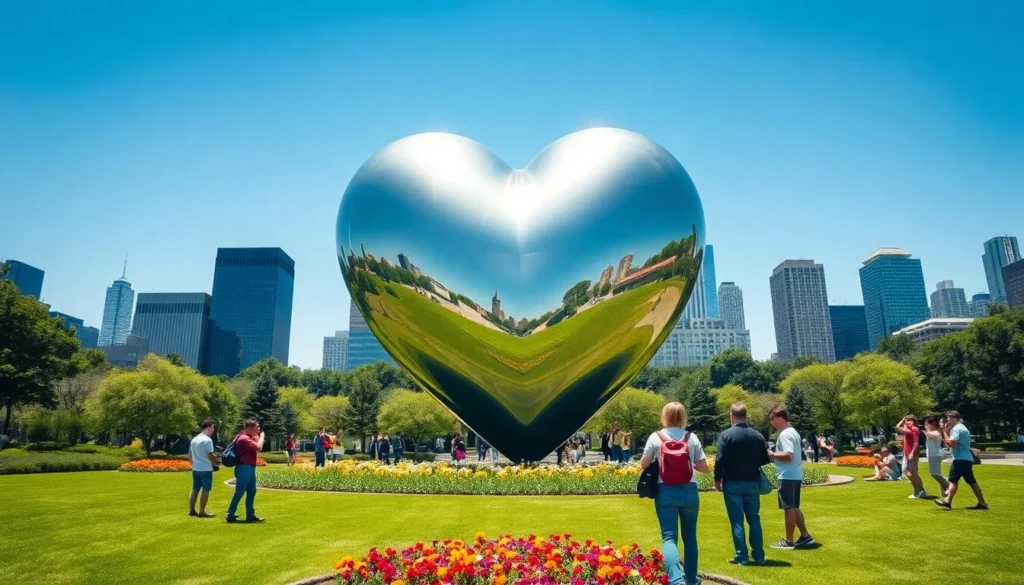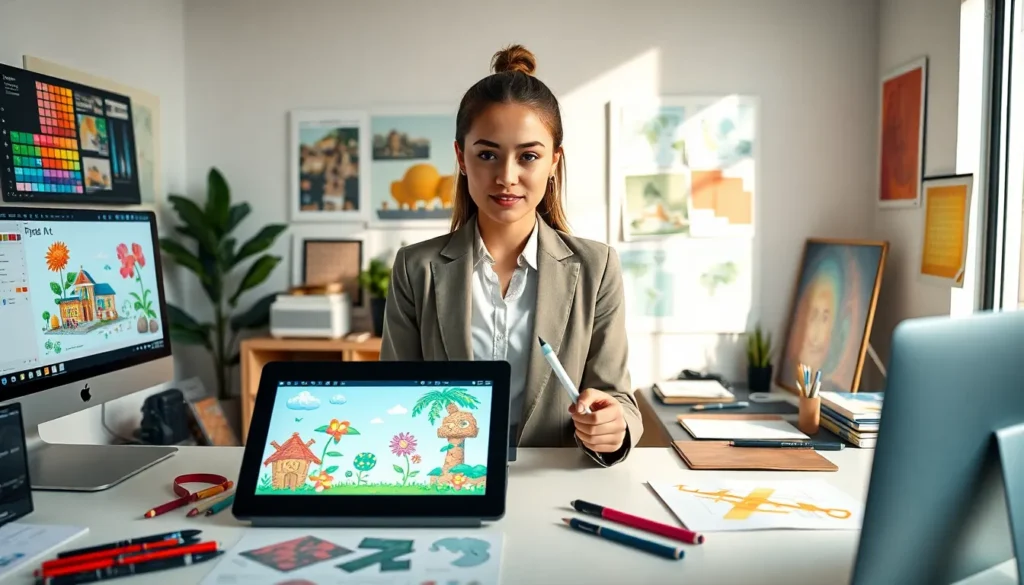Table of Contents
ToggleDiving into the world of clay sculpture is like stepping into a delightful mess of creativity and fun. For beginners, the thought of shaping a lump of clay into a masterpiece can be both thrilling and a tad intimidating. But fear not! With a pinch of imagination and a dash of enthusiasm, anyone can transform clay into something spectacular—even if it starts out looking like a lumpy potato.
Clay Sculpture Ideas for Beginners
Beginners can explore a variety of clay sculpture ideas that spark creativity. Animal figures serve as an approachable entry point in clay modeling. Simple forms like cats, dogs, or birds allow for a focus on basic shapes and textures.
Figurines present another engaging avenue for novices. Creating human figures, mythical creatures, or abstract forms fosters imagination. Beginners can pay attention to proportions and anatomy, enhancing their sculpting skills with practice.
Planters make for functional and artistic projects. Designing small pots or decorative planters combines aesthetics with utility. Sculptors can personalize these items with intricate designs, promoting self-expression.
Game pieces inspire playful creation. Crafting custom chess pieces or board game tokens invites exploration of themes and characters. Beginners build both artistic ability and engagement through interactive designs.
Functional items, such as tiles or coasters, offer unique opportunities to blend art with practicality. Designing textured or painted tiles helps beginners learn surface techniques while experimenting with color and pattern.
Hearts, stars, and other simple shapes provide a perfect introduction to sculpting. These foundational forms emphasize ease and instant satisfaction. Mastering basic shapes builds confidence for more complex projects.
By utilizing these ideas, beginners can enjoy the process of sculpting without feeling overwhelmed. Each project serves as a stepping stone toward greater skill and creativity in clay sculpture.
Tools and Materials Needed
Beginners can create amazing clay sculptures with the right tools and materials. Starting with quality items makes the sculpting experience smoother and more enjoyable.
Essential Tools
Basic tools include a sculpting knife, which allows for precise cuts. A variety of shaping tools, such as wire and rib tools, provides versatility in crafting different textures. A rolling pin helps achieve uniform thickness in clay slabs, essential for many projects. Additionally, wooden paddles assist in smoothing surfaces, ensuring a polished finish. Finally, a good work surface keeps the clay in place and allows easy manipulation.
Recommended Clay Types
Different clay types suit various projects. Air-dry clay offers convenience as it doesn’t require a kiln and is easy to work with, making it ideal for beginners. Polymer clay, known for its vibrant colors, hardens with baking, allowing for detailed designs. Additionally, stoneware clay provides durability and withstands high temperatures, suitable for functional sculptures. Finally, earthenware clay is perfect for colorful, decorative pieces, as it’s easy to glaze. Selecting the right clay enhances the sculpting process and supports creative expression.
Basic Techniques to Get Started
Clay sculpture blending creativity and technique requires understanding key methods and finishing touches. Beginners can easily master these to enhance their works.
Sculpting Methods
Creating shapes begins with pinch, coil, and slab techniques. Pinching clay forms simple bowls or cups through fingers pressing and shaping. Coiling builds up walls by stacking rope-like clay pieces for pots or vases. Slab technique uses flat sheets to construct more complex structures, ensuring even thickness with a rolling pin. Adding texture becomes crucial; tools like stamps and brushes add character. Beginners often enjoy using these methods for projects like animal figures or decorative tiles.
Finishing Touches
Finishing transforms a sculpture into a polished piece. Smoothing surfaces with water or a damp sponge helps remove imperfections. Drying techniques matter, too; slow drying reduces cracking risk. Applying paint or glaze enhances visibility and protects the sculpture. Beginners typically appreciate using non-toxic acrylic paints for ease and vibrancy. Sealing the piece provides long-lasting durability, with options like clear spray sealants for added protection against moisture and wear.
Creative Clay Sculpture Ideas
Beginners can find endless inspiration in clay sculpture. A few creative suggestions encourage experimentation and skill development.
Animal Sculptures
Animal sculptures represent a popular choice among beginners. Cats and dogs offer approachable shapes, allowing for a focus on basic form and texture. Beginners can also explore bird figures, which provide a chance to experiment with wings and feathers. Using simple shapes as starting points helps build confidence. Combining textures, like smooth fur and rough grass, enhances realism. These sculptures not only promote imagination but also improve hand-eye coordination for novice artists.
Abstract Forms
Abstract forms encourage creativity without the constraints of realism. Artists can play with shapes and colors, enabling personal expression through non-representational designs. Curved lines, geometric forms, or free-flowing shapes allow beginners to explore their artistic voice. Experimenting with different colors can create a captivating visual impact. These designs invite unique interpretations and foster a sense of freedom in the sculpting process. Abstract work provides room for fun and innovation, making it an excellent choice for emerging sculptors.
Functional Pieces
Functional pieces combine artistry and utility, challenging beginners to think creatively. Planters serve as a perfect starting point, allowing for unique designs while serving a practical purpose. Game pieces like chess or checkers also encourage creativity while maintaining functionality. Utilizing clay’s versatility leads to home décor items or kitchenware, blending aesthetic appeal with daily use. These projects not only enhance sculpting skills but also result in tangible, usable art. Emphasizing functionality promotes an engaging sculpting experience that inspires ongoing exploration.
Tips for Successful Sculpting
Sculpting can be an enjoyable process when beginners keep a few key tips in mind. Prioritizing good preparation ensures a smoother experience and better results.
Common Mistakes to Avoid
Neglecting to plan the sculpture can lead to challenges later on. Beginners often forget to keep clay moist, resulting in cracks during drying. Rushing the drying process often damages the final product. Overworking the clay may lead to weakening, so it helps to work in manageable sessions. Additionally, avoiding too much detail early on allows for adjustments during the crafting process. Each of these mistakes can hinder the overall sculpting experience.
Inspiration Sources
Exploring various sources can ignite creativity in beginners. Nature serves as a rich source of inspiration; plants and animals exhibit unique forms and textures. Art books often showcase different styles, prompting new ideas. Online platforms like Pinterest and Instagram provide a plethora of visual references. Visiting local galleries or museums introduces sculptors to professional work, sparking enthusiasm. Lastly, joining local art classes or community groups fosters collaboration and further inspires creativity.
Conclusion
Embarking on a clay sculpture journey opens up a world of creativity and self-expression. With the right tools and materials beginners can easily create beautiful pieces that reflect their unique vision. From simple animal figures to functional art like planters the possibilities are endless.
Encouraging experimentation and exploration is vital. Each project serves as a stepping stone to greater skill and confidence. By learning techniques and avoiding common pitfalls beginners can enjoy the process while developing their artistry.
Inspiration is everywhere. Whether it’s nature or online platforms the journey of sculpting clay is just beginning. Embracing this art form can lead to endless joy and fulfillment.





